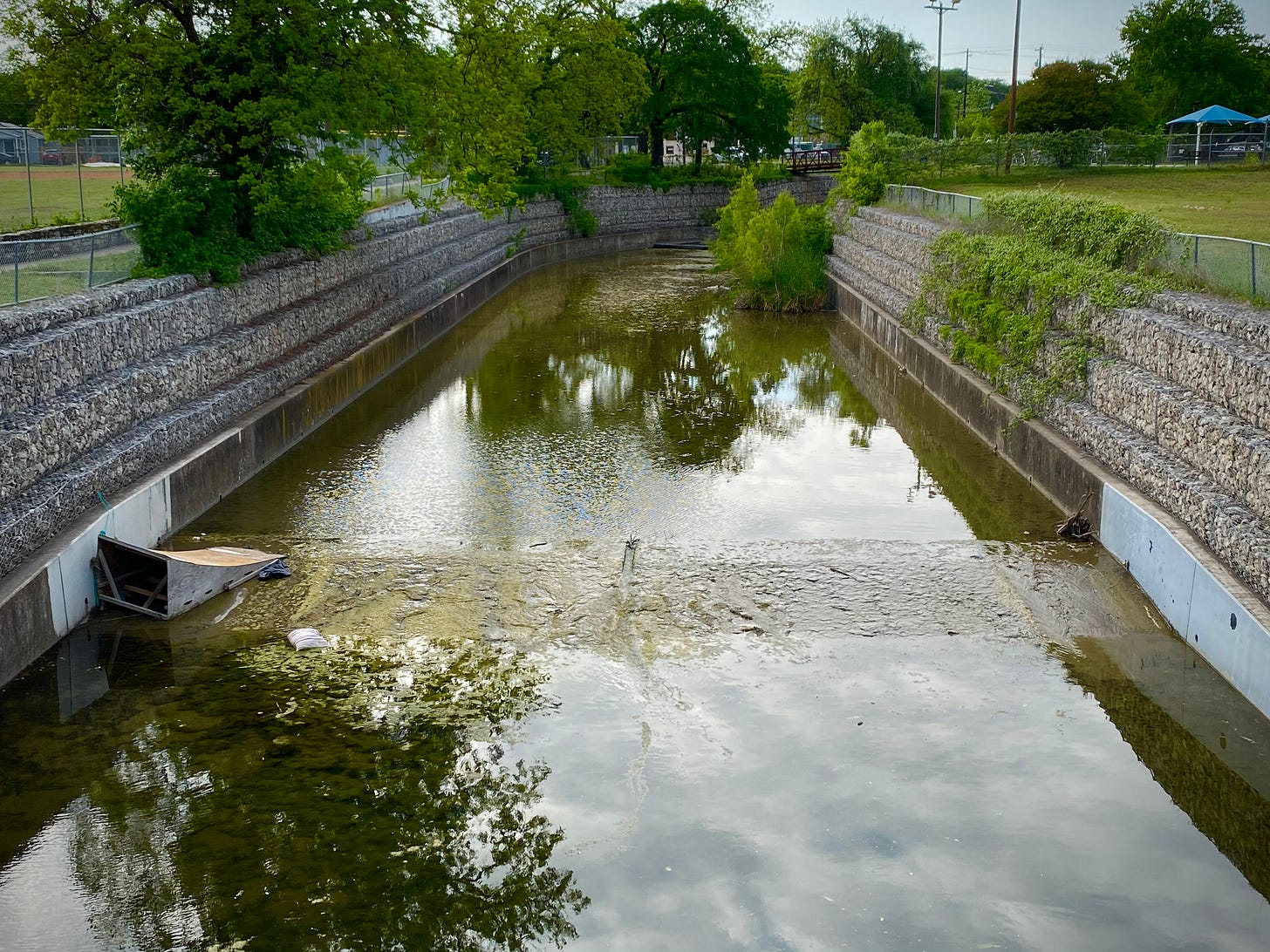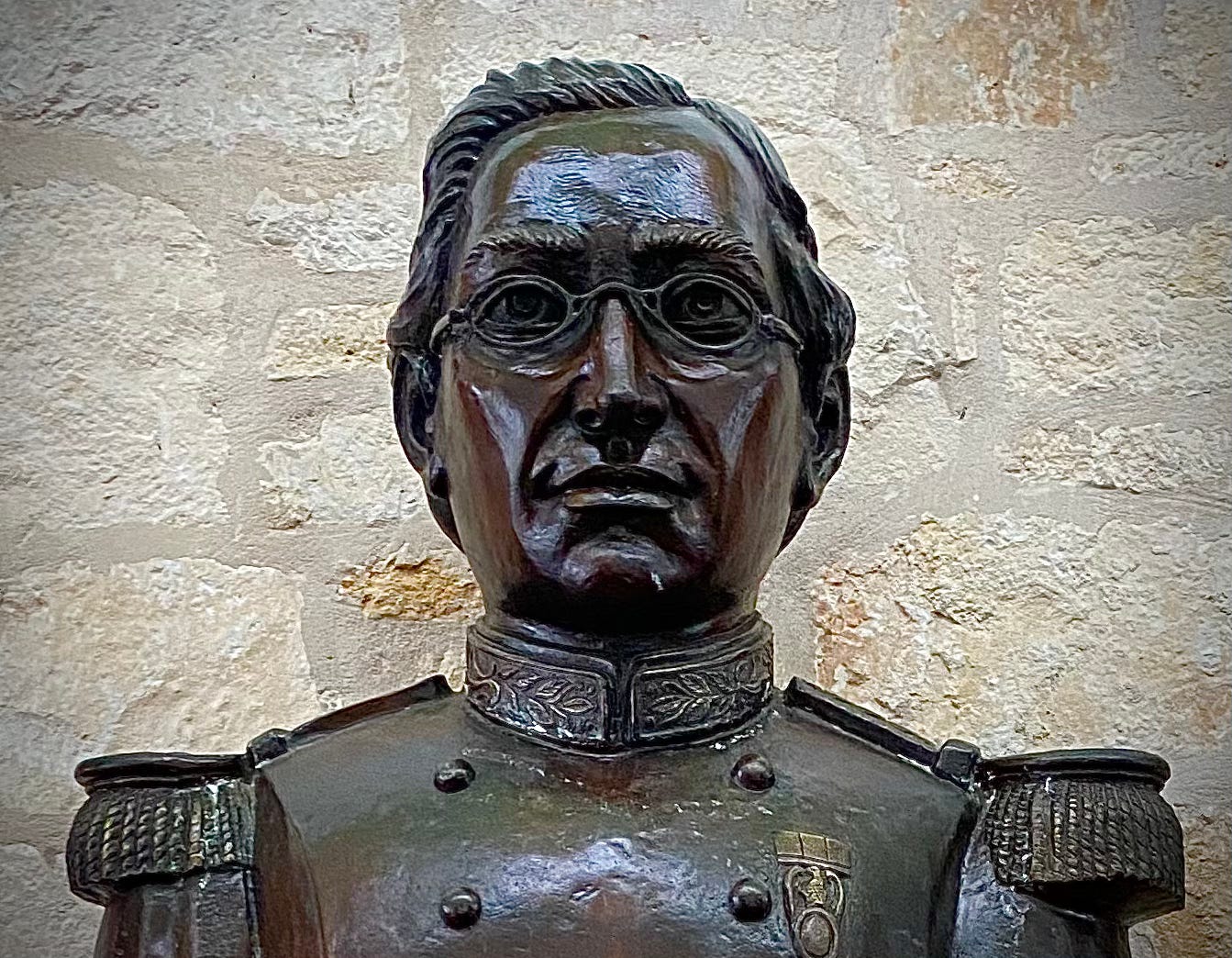Earth Day in the Pleasant Valley
Tuesday morning the New York Times ran a report from Syria about refugees from that country’s civil war who have resettled in the last redoubt they can find: ancient ruins of long-dead cities in the far northwest of the country, at the outer edge of the only territory still held by the rebels. It’s the kind of piece where the photos seem to tell the whole story—a tent camp erected in the crumbling marbles of a Roman temple, solar panels and a satellite TV dish atop the walls of a Byzantine trading post, all populated with hard and hungry-looking kids.
As you read more deeply about the sites, you learn that the cities were abandoned a millennia ago due to an earlier bout of climate change.
That story was still in my mind Wednesday evening when I went to go vote at a nearby community center. I went on foot, and used the opportunity to get my run in, after an intense few days of work.
Early voting began this week on a slate of local referendums, mostly related to matters of municipal governance. This ballot is getting more attention than most of its kind, because of the second proposition up for popular vote: whether to override the City Council’s 2019 vote to decriminalize public camping. That vote, followed by the Covid-19 pandemic, has resulted in an escalating crisis in Austin, as the proliferation of homeless camps along public roadways, under overpasses, in building nooks by the sidewalks, and along the downtown riverfront greenbelt trail credited to Lady Bird Johnson, tests the tension between Austin’s bourgeois proclivities and liberal self-conception. The fastest-growing city in America is also one of the most economically segregated, a reality many folks don’t want to have any close encounters with.
My route to the polls took me past the old abandoned lighting factory that I wrote about last month, where all week a landscaping crew was busy cutting back the vegetation that had helped the building achieve a nice post-apocalyptic aesthetic, probably in preparation for sale and/or redevelopment, as the early emergence from Covid has real estate capital coming back out to play. Mostly they cut back little volunteer trees and thick vines that had grown into the structure or fences, but the first thing they did was to cut down this beautiful old pecan tree that was outside the boarded-up front entrance, probably without a permit.
I have seen many a drifter enjoying the shade of that tree over the years, and even more urban foragers picking the nutty fruit it drops to the ground every fall. Tuesday it was a horrific limbless trunk, like the arboreal version of a human torso that has lost its head and arms. Wednesday it was just a stump in the ground. I stopped to try to count the rings, but there were too many. I was struck by how thin the rings were, evidence of how many years that beautiful hot country hickory had to survive in this rugged climate to grow that canopy.
The street that divides this part of town from the rest of Austin is called Pleasant Valley. It really is a valley, bisected by the Lower Colorado River below the last dam, full of creeks and ancient springs that feed it, and the river and its tributaries, which often flood, manage to preserve a lot of green space along their banks. But the modern name of the neighborhood, Govalle, which incorporates the Spanish word for valley, is actually, in the funny way American place names often encode a more complex demographic history, an Anglo-Hispanicization of the name Swedish immigrants gave this area when they arrived in the 1850s: Ga Valla, which apparently means “good pasture.”
It doesn’t take much to imagine what promising farm and ranch land these alluvial plains on the north bank of the river were when the Swens showed up. Or to appreciate how many of the tall trees that cause side streets to get names like Shady Lane have been here longer than the city that wants to cut them down to make room for air-conditioned buildings designed by spreadsheets.
The irony was not lost on me that I was going to vote on whether to re-criminalize public homelessness in a community center that has been surrounded by homeless camps since long before the recent change in law. The dudes were there under the live oaks as always, hanging out as late afternoon slipped into evening and the sun worked on getting its pink on.
The greenbelt that cuts through here isn’t as nice as the one Lady Bird made downtown, the one whose recreational users and Chamber of Commerce boosters are championing the ballot initiative to push the homeless back into hiding. The creek that runs behind the community center is paved. When you read the reports of the floods they had on these creeks before the dam was built, you understand why, but it doesn’t make it any less ugly, or against nature.
A couple of years ago, before the pandemic, I volunteered in the local homeless count, taking the census in the neighborhood just across the river, along a street called Riverside Drive where the median is now completely taken up with camps. We set out at 3 a.m. on a Saturday morning, along similar creeks. Under every little overpass, we shined our flashlights and found rows of shanties packed in wherever the structure afforded a flat surface and the shelter of the bridge or road.
The occupants were diverse—disabled veterans, pregnant teens, lost boys. Further back from the road, in the urban woods, we found mostly older men with wizard beards, the Robinson Crusoes of the American city. The experience made me better understand how many more people are living on the streets and in the woods than any of the counts can capture, how effectively they hide in plain sight, and how many different paths there are whereby our Darwinian approach to economic welfare can drive one into that life on the other side of urban precarity.
Behind the community center as I walked up, I crossed the creek again. That creek is often dry, but Wednesday it had filled with spring rains, and the trash they carried. Willows and new vines were growing up out of the cracks in the concrete, and in the early evening light, maybe because of the algal bloom and the way the reflection of the sky appeared in the water, you could almost imagine the greener future that brutalized waterway could still find its way to if left alone, notwithstanding the skate ramp that had washed up on the weir dam, and the styrofoam cups and wild tires bobbing around below it.
When I came back out from voting, I noticed motion in the water. A huge soft-shell turtle, swimming in the trashed out creek, poking that long-necked head up between all the tiny particles of trash. Then I noticed another turtle, a more common red-eared slider, nearby, sliding through our filth.
It made me think how hypocritical are the protests of middle-class Austin driving this referendum, the idea that we can’t tolerate people camping along the river and creeks with all their trash. The entire city is a permanent camp along the river that produces so much trash they make new mountains of it at the edge of town, and the trash in the waterways has always been there, mostly from our backyards. Public camping by the homeless is a mirror we don’t like to look at, making us have daily encounters with the poverty that’s always close by, but usually hidden across the geographic divides of class and race. It’s also a window into a future likely to look a lot more like those Syrians living in the ancient ruins than we can imagine. The business model the city embodies is broken and out of balance, as evidenced by the condition of almost every creek that runs through it.
Looking down at the water, I saw the reflection of motion in the sky. A flock of the gullwings of riverine summer. And then a big heron backlit by a muted sunset, its pterosaur profile reminding you of the deep time its bones traced, a bird that has somehow survived our overbuilt desecration of its habitat, and a couple of generations of hunting it to adorn our caps with its feathers.
The community center where I voted is named after Ignacio Seguín Zaragoza, a Tejano from the town of Bahía del Espíritu Santu (now Goliad, Texas) who went on to become hero of the Battle of Puebla. The idea of that battle is one that always seems to puzzle the journalists who write about the holiday that commemorates it, Cinco de Mayo—a victory in a war against French colonizers that was ultimately lost, and that is not considered that important in Mexican history. But when you think about it as the adopted holiday of the people with deeper lineages in this particular colonized space between the Rio Bravo and the Red River, a never-give-up dream of the possibility of rebellion and self-determination, a kind of anti-Alamo, it makes more sense.
And when you think about it on the eve of Earth Day, on a trashed-out urban creek, as our broken politics confronts the failure of progressive urbanity to keep people from slipping into neo-nomadology, as nature begins to correct our hubris in acting as the plantation masters of an entire planet, you find yourself wondering if maybe that old hippie Ecology Flag could be repurposed as a different kind of bandera, the kind that you carry with the bandolero of authentic rebellion against a failed and unjust system.
Stay thirsty, my friends.
In other news
If you’ve never seen a 1970s Ecology Flag, this Smithsonian piece about the movement that birthed it is a good place to start.
Saturday’s New York Times had a wonderful interview with Rachel Kushner about the influence of visual artists on her work that included a discussion of my late brother Alex Brown and a reproduction of one of his more recent paintings. It was a nice thing to see on what would have been his birthday. We’ll have more news soon about the foundation and residency we have established in Alex’s name.
Lastly, I’ve been reading Moby-Dick this spring, and this paragraph that ends Chapter 58, as the Pequod sails through a sea so flush with microscopic marine life that it looks like a field of wildflowers, resonated with me:
“Consider all this; and then turn to this green, gentle, and most docile earth; consider them both, the sea and the land; and do you not find a strange analogy to something in yourself? For as this appalling ocean surrounds the verdant land, so in the soul of man there lies one insular Tahiti, full of peace and joy, but encompassed by all the horrors of the half known life. God keep thee! Push not off from that isle, thou canst never return!”
Have a safe week.















Another powerful piece. Thank you.
I greatly enjoy your dispatches from another part of Austin. Protecting the vulnerable Austin homeless community is one of the things I am passionate about so this one especially touched me.
On another note--one of my friends took a picture this weekend that looks a lot like your photo captioned "Viva las ramas". We could not come to a consensus on the purpose of those hexagonal wooden things that are in some parks. For a game of some sort?